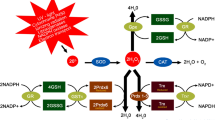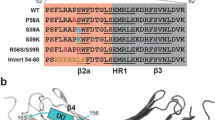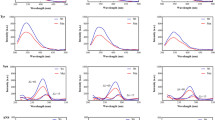Abstract
The purpose of this study was to investigate the effect of metal-catalyzed oxidation by H2O2 on the structure, oligomerization, and chaperone function of αA- and αB-crystallins. Recombinant αA-and αB-crystallins were prepared by expressing them in E. coli and purifying by size-exclusion chromatography. They were incubated with 1.5 mM H2O2 and 0.1 mM FeCl3 at 37 ∘C for 24 hrs and the reaction was stopped by adding catalase. Structural changes due to oxidation were ascertained by circular dichroism (CD) measurements and chaperone activity was assayed with alcohol dehydrogenase (ADH) and insulin as target proteins. The oligomeric nature of the oxidized proteins was assessed by molecular sieve HPLC. The secondary structure of the oxidized αA- and αB-crystallins has been substantially altered due to significant increase in random coils, in addition to decrease in β-sheet or α-helix contents. The tertiary structure also showed significant changes indicative of different mode of folding of the secondary structural elements. Chaperone function was significantly compromised as supported by nearly 50% loss in chaperone activity. Oxidation also resulted in the formation of higher molecular weight (HMW) proteins as well as lower molecular weight (LMW) proteins. Thus, oxidation leads to disintegration of the oligomeric structure of αA- and αB-crystallins. Chaperone activity of the HMW fraction is normal whereas the LMW fraction lacks any chaperone activity. So, it appears that the formation of the LMW proteins is the primary cause of the chaperone activity loss due to oxidation.
Similar content being viewed by others
References
Srivastava SK, Lal AK, Ansari NH: Defense system of lens against oxidative damage: effect of oxidative challenge on cataract formation in glutathione peroxidase-deficient-acatalasemic mice. Exp Eye Res 31: 425–433, 1980
Spector A: The search for a solution to senile cataracts. Proctor Lecture. Invest Ophthalmol Vis Sci 25: 130–146, 1984
Zigler JS, Goasy JD: Singlet oxygen as a possible factor in human senile nuclear cataract development. Curr Eye Res 3: 59–65, 1984
Giblin FJ, McCready JP, Kodama T, Reddy VN: A direct correlation between the levels of ascorbic acid and H2O2 in aqueous humor. Exp Eye Res 38: 87–93, 1984
Spector A, Garner WH: Hydrogen peroxide and human cataract. Exp Eye Res 33: 673–681, 1981
Zigler JS Jr, Huang UL, Du XY: Oxidative modification of lens crystallins by H2O2 and chelated iron. Free Radical Biology and Medicine 7: 499–505, 1989
Amici A, Levine RL, Tsai L, Stadtman ER: Conversion of amino acid residues in proteins and amino acid homopolymers to carbonyl derivatives by metal – catalyzed oxidation reaction. J Biol Chem 264: 3341–3346, 1989
Stadtman ER: Oxidation of free amino acids and amino acid residues in proteins by radiolysis and by metal-catalyzed reactions. Ann Rev Biochem 62: 797–821, 1993
Barlett BS, Stadtman ER: Protein oxidation in aging, disease and oxidative stress. J Biol Chem 272: 20313–20316, 1997
Lund AL, Smith JB, Smith DL: Modifications of water- insoluble human lens α-crystallins. Exp Eye Res 63: 661–672, 1996
Takemoto L, Horwitz J, Emmos T: Oxidation of the N-Terminal methionine of lens αA-Crystallin. Current Eye Res 11: 651–655, 1992
Finley EL, Dillon J, Crouch RK, Schey KL: Sites and extent of oxidation of soluble human α crystalline with age. Invest Ophthal Vis Sci 40: S 301, 1999
Cherian M, Abraham EC: Decreased molecular chaperone property of α crystallin due to post translational modifications. Biochem Biophys Res Commun 208: 675–679, 1995
Smith JB, Jiang X, Abraham EC: Identification of hydrogen peroxide oxidation sites of αA- and αB-crystallins. Free Rad Res 26: 103–111, 1997
Shroff NP, Cherian M, Bera S, Abraham EC: Mutation of R116C results in highly oligomerized αA-crystallin with modified structure and defective chaperone like function. Biochemistry 39: 1420–1426, 2000
Laemmli UK: Cleavage of Structural proteins during the assembly of the head of bacteriphage T4. Nature (London) 277: 680–685, 1970
Young JT, Wu CS, Martinez HM: Calculations of protein conformation from circular dichroism. In: C.H.W. Hirs, S.N. Timasheff, (eds). Methods of Enzymology, Vol.130, Academic press, NewYork, 1986, pp. 208–269
Shroff NP, Bera S, Cherian SM, Abraham EC: Substituted hydrophobic and hydrophilic residues at methionine-68 influence the chaperone-like function of αB-crystallin. Mol Cell Biochem 220: 127–133, 2001
Kelley PB, Abraham EC: Thermally induced disintegration of the oligomeric structure of αB-crystallin mutant F28S is associated with diminished chaperone activity. Mol Cell Biochem 252: 273–278, 2003
Lerman S, Megaw JM, Moran MN: Further studies of the effects of UV radiation on the human lens. Ophthal Res17: 354–361, 1985
Swamy MS, Green K, Abraham EC: Inhibition of cataracts in moderately diabetic rats by aminoguanidine. Exp Eye Res 62: 505–510, 1996
Spector A, Wang GM, Wang RR, Garner WH, Moll H: The prevention of cataract caused by oxidative stress in cultured rat lens: H2O2 and photochemically induced cataract. Curr Eye Res 12: 163–179, 1993
Cherian M, Smith JB, Jiang X, Abraham EC: Influence of protein-glutathione mixed disulfide on the chaperone-like function of α-crystallin. J Biol Chem 272: 29099–29103, 1997
Cherian M, Smith JB, Xiang Y, Abraham EC: Intrapolypeptide disulfides in human αA crystallin and their effect on chaperone –like function. Mol cell Biochem 199: 163–167, 1999
Thampi P, Abraham EC: Influence of the C-terminal residues on oligomerization of αA crystallin. Biochemistry 42: 11857–11863, 2003
Author information
Authors and Affiliations
Corresponding author
Rights and permissions
About this article
Cite this article
Rajan, S., Horn, C. & Abraham, E.C. Effect of Oxidation of αA- and αB-Crystallins on their Structure, Oligomerization and Chaperone Function. Mol Cell Biochem 288, 125–134 (2006). https://doi.org/10.1007/s11010-006-9128-4
Received:
Accepted:
Published:
Issue Date:
DOI: https://doi.org/10.1007/s11010-006-9128-4




